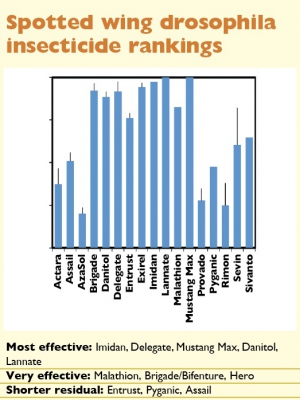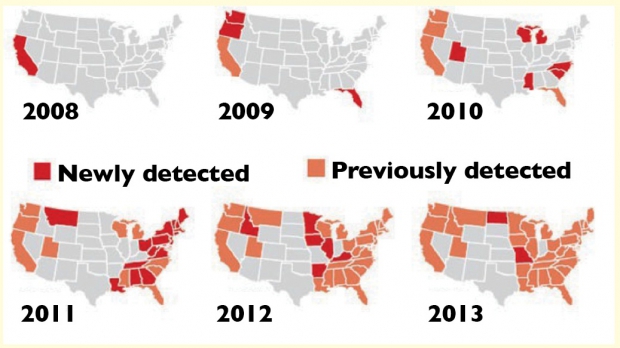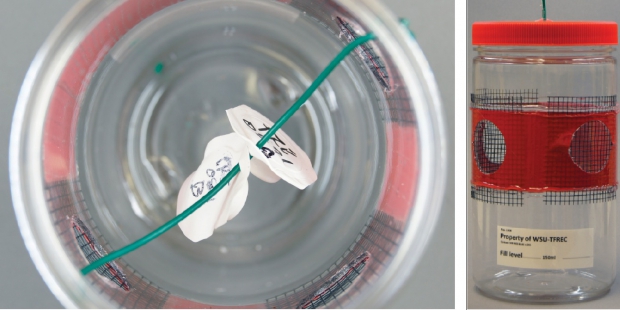
Lary Gut
Michigan growers of berries of all kinds have been hammered by spotted wing drosophila since the invasive fruit fly was first found in the state in 2010. Grapes and peaches are also targets, and so are cherries, somewhat.
“With cherries, we’re on the borderline of getting into trouble,” said Michigan State University entomologist Dr. Larry Gut.
He’s been part of Michigan’s SWD Response Team that includes several fruit entomologists who run a trapping program to monitor timing of emergence, egg laying, and fruit infection, and investigate ways to prevent damage.
“We found none in the fruit before harvest last year,” Gut said about spotted wing drosophila in cherries.
In Michigan, tart cherries and sweet cherries for brining are harvested once-over with shakers and catching frames, mostly during July. Fruit left on the trees after harvest are infested shortly after insecticide applications stop.
Growers have to spray until close to harvest to protect fruit from cherry fruit flies, and that probably controls spotted wing drosophila as well, if they choose the right insecticides. Gut has been evaluating those for efficacy and has a list of those that do the job.

Spotted wing drosphila insecticide rankings. (SOURCE: Michigan State University)
Michigan’s approach to this new, invasive fruit fly has been to trap to know where it is and when, keep growers informed, evaluate insecticides to find good controls, and hope for breakthroughs that will tame this insect.
Oregon State University entomologists—Peter Shearer and others—traveled to South Korea and collected five species of parasitoid wasps that are being raised in quarantine at the University of California, Berkeley.
“One of them appears to be a specialist on SWD,” Gut said. It makes it easier to obtain a release permit if the parasitoid attacks only the target species. Some target larvae, others pupae.
Unlike ordinary fruit flies, spotted wing drosophila females can force their way into unripe fruit with a sawlike ovipositor. They don’t need to wait for the fruit to get overripe and soft. Females live about nine weeks and lay up to 300 eggs that hatch into small, white worms.
Gut noted that cherries become attractive to the flies when color starts to change.
Gut has also noted that spotted wing drosophila seems to emerge later in the summer if weather has been harsh the previous winter. Since it was quite cold in Michigan on several occasions last winter, Gut is predicting a later emergence this coming summer. Cherry growers may continue to stay on the right side of the borderline.
Last year, spotted wing drosophila emerged in southwest Michigan July 15 and July 23 in northwest Michigan, where both sweet and tart cherries are grown. By those dates, harvest is usually just about complete.

Spread of spotted wing drosophila (SOURCE: The Boston Globe and Hannah Burrack, NCSU)
Monitor with traps
Michigan State University has developed a Web site, www.ipm.msu.edu, with several pages devoted to spotted wing drosophila, including weekly reports that start in mid-June and continue through August. In addition to 60 trapping sites monitored by the MSU entomologists, Gut is urging growers to monitor their orchards with traps.
“Because SWD reproduces so quickly under optimum conditions, the first catch information is vital to activate pest management programs to prevent rapid population increases and potential infestations in a region,” said Dr. Nikki Rothwell, coordinator of the Northwest Michigan Horticultural Research Station and a participant in the trapping program.
When temperatures get about 65 to 70 degrees, generation times can be as short as 12 days, she said.
Gut and the MSU team have been experimenting with traps trying to find those that are very sensitive and will pick the flies up early. The flies are attracted to vinegar, so a common trap has been a clear plastic cup baited with vinegar.
An improved trap was one baited with yeast and flour. It attracted more flies but smelled “so horrible,” Gut said, it was hard to get the technicians to take the flies out to identify and count them. Only the males have the characteristic spots on their wings; females must be identified from their serrated ovipositors.
This last year, Gut’s MSU colleagues tested a lure from Trécé made with a blend of volatiles and a soapy water drowning solution, which worked even better and caught more flies—and smelled much better.
In tests conducted across the country, researchers found that the insecticides that worked best against spotted wing drosophila included Imidan (phosmet), Delegate (spinetoram), Mustang Max (zeta-cypermethrin), Danitol (fenpropathrin), and Lannate (methomyl). Malathion, Brigade/Bifenture (bifenthrin), and Hero were a step lower, but still “very effective.” Sevin (carbaryl) was less effective. PyGanic (pyrethrins) and Assail (acetamiprid) were weak to fair, and Entrust (spinosad) rated good, but these three have short residual effect.
Some newer materials are being tested, and work quite effectively, Gut said, but are not yet labeled. •

(Left) Trécé has introduced a lure for spotted wing drosophila that appears more effective and is easier to use than the cider apple vinegar, yeast, and wine concoctions tried before. (Right) The latest iteration of the spotted wing drosophila trap developed by Elizabeth Beers at WSU. It’s called the PBJ trap because of its resemblance to a peanut butter jar. (Courtesy Dr. Elizabeth Beers, Washington State University)






Leave A Comment